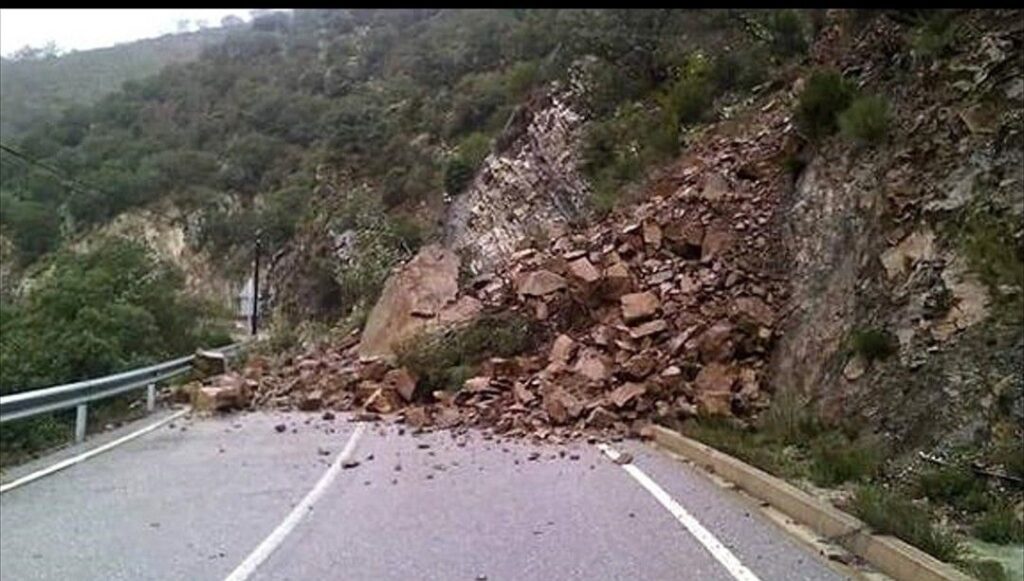August 6, 2025
Shimla, Himachal Pradesh – After days of relentless downpours in neighboring Uttarakhand, Himachal Pradesh is now facing the brunt of nature’s fury, as torrential rainfall triggered flash floods and landslides across several districts. On Tuesday morning, a massive landslide near Kandaghat shimla highway forced the closure of the vital Shimla-Kalka National Highway (NH-5), bringing movement to a complete halt and stranding hundreds of vehicles.
Authorities have issued red alerts for flash floods in multiple districts, while the India Meteorological Department (IMD) has forecasted continued rainfall in the region for the next 48 hours. This worsening weather condition has sparked fears of another disaster following the cloudburst in Uttarkashi, which claimed several lives and displaced entire villages.

What Happened?
According to Himachal Pradesh State Disaster Management Authority (SDMA), heavy overnight rain triggered landslides in Solan, Sirmaur, Kullu, Mandi, and Shimla districts. The most significant disruption occurred near Kandaghat in Solan, where a huge portion of NH-5 was buried under boulders and debris. Videos circulating on social media showed mud, rocks, and uprooted trees crashing onto the highway, forcing emergency services to divert traffic and begin urgent clearance operations.
shimla highway/shimla highway/shimla highway/shimla highway
In Shimla and its outskirts, flash floods damaged roads, homes, and water pipelines, leaving many localities without electricity or drinking water.
District Collector Aditya Negi said,
“NDRF and SDRF teams have been dispatched to the impacted locations. Tourists and residents are being warned to avoid travel unless absolutely necessary.”
Torrential Rain: Triggering Devastation
As per the IMD, Shimla recorded 142 mm of rain in just 24 hours, while Solan received 136 mm—well above the danger mark.
Flash floods were reported in parts of Chamba, Kullu, and Mandi, where riverbanks began to overflow, washing away footbridges and minor road infrastructure. At least 17 major landslides were reported across the state by Tuesday afternoon.
In Kullu, two bridges were reportedly washed away near Manikaran, cutting off access to nearby villages. Schools and colleges in high-risk districts have been closed as a precaution.
shimla highway/shimla highway/shimla highwayshimla highwayshimla highway
Human Toll and Emergency Response
So far, no casualties have been officially confirmed in Himachal, but property loss has been extensive. Over 200 tourists and locals have been evacuated from vulnerable areas. However, rescue operations remain challenging due to blocked roads and adverse weather.
During an emergency news briefing, Sukhvinder Singh Sukhu, the chief minister of Himachal Pradesh, said:
“We are closely monitoring the situation. All agencies are working round the clock to ensure public safety. We appeal to citizens to stay indoors and avoid hilly roads and riversides.”
Meanwhile, rail and air services have also been affected. Flights to and from Shimla were delayed due to poor visibility, and the Kalka-Shimla railway service has been suspended temporarily after reports of debris on the tracks.
Context: Himalayan States Under Climate Pressure
This incident comes just 24 hours after a catastrophic cloudburst in Uttarkashi killed at least four people and swept away homes, hotels, and bridges in Dharali village. The back-to-back natural disasters in Uttarakhand and Himachal have reignited the debate around climate change, unregulated construction, and environmental degradation in India’s fragile hill states.
Environmental experts have repeatedly warned that urban sprawl, reckless deforestation, and poorly managed tourism in ecologically sensitive zones are exacerbating the impact of heavy monsoons.
Ritwik Dutta, an environmental lawyer, said:
“What we’re witnessing in Himachal and Uttarakhand is not just a weather event, but a man-made crisis. There’s a clear lack of long-term vision in planning and disaster preparedness.”
Economic Impact
The ongoing disaster is also expected to severely impact Himachal’s tourism-dependent economy. August is considered the monsoon tourism season for destinations like Shimla, Manali, and Dalhousie, but with roads cut off and alerts in place, hotels are reporting mass cancellations.
According to the Himachal Pradesh Tourism Department, more than 1.2 lakh tourists were expected this month, but footfall may decline by over 60% if the current crisis continues.
Hoteliers’ association president Ramesh Kapoor told local media:
“We are facing massive losses. Many tourists are stuck, and bookings have dried up completely for the coming weeks.”
Government Advisory
The Himachal Pradesh government has issued strict advisories to tourists and residents, including:
Avoid travel to high-altitude or landslide-prone areas.
Refrain from river-based activities such as rafting or swimming.
Keep emergency kits ready.
Follow updates on weather apps and SDMA advisories.
The National Disaster Response Force (NDRF) has positioned multiple rescue units across Solan, Shimla, and Kullu districts. Meanwhile, the Army and ITBP have been kept on standby in case evacuations escalate.
What’s Next?
As weather forecasts predict continued heavy rain till August 7, the focus remains on rescue, relief, and damage control. Restoration of blocked highways, electricity, and mobile connectivity is underway in affected zones.
With both Himachal and Uttarakhand reeling under disaster, this monsoon season has proven particularly harsh for India’s northern hill states. While immediate damage control is the top priority, the need for long-term environmental planning, sustainable infrastructure, and climate resilience is becoming more urgent than ever.
Source: NDTV – Cloudburst in Uttarakashi Causes Flash Floods and Deaths in Uttarakhand
Read full report on NDTV
Stay updated with the latest headlines across India and the world by visiting our Home Page.
